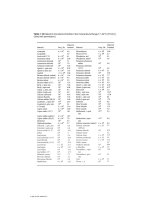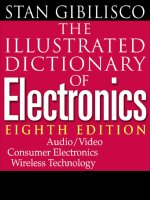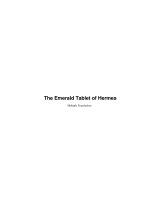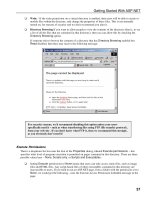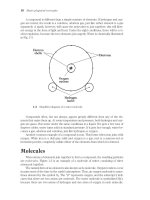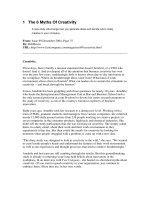Tài liệu The Resource Hanbook of Electronics P2 docx
Bạn đang xem bản rút gọn của tài liệu. Xem và tải ngay bản đầy đủ của tài liệu tại đây (749.73 KB, 20 trang )
Table 1.10 Dielectric Constants of Solids in the Temperature Range 17–22°C (
From
[1].
Used with permission
.)
© 2000 by CRC PRESS LLC
Whitaker, Jerry C. “International Standards and Constants”
The Resource Handbook of Electronics.
Ed. Jerry C. Whitaker
Boca Raton: CRC Press LLC, ©2001
© 2001 by CRC PRESS LLC
Chapter
2
International Standards and
Constants
2.1 Introduction
Standardization usually starts within a company as a way to reduce costs associated
with parts stocking, design drawings, training, and retraining of personnel. The next
level might be a cooperative agreement between firms making similar equipment to
use standardized dimensions, parts, and components. Competition, trade secrets, and
the NIH factor (not invented here) often generate an atmosphere that prevents such an
understanding. Enter the professional engineering society, which promises a forum
for discussion between users and engineers while downplaying the commercial and
business aspects.
2.2 The History of Modern Standards
In 1836, the U.S. Congress authorized the Office of Weights and Measures (OWM)
for the primary purpose of ensuring uniformity in custom house dealings. The Trea
-
sury Department was charged with its operation. As advancements in science and
technology fueled the industrial revolution, it was apparent that standardization of
hardware and test methods was necessary to promote commercial development and to
compete successfully with the rest of the world. The industrial revolution in the 1830s
introduced the need for interchangeable parts and hardware. Economical manufacture
of transportation equipment, tools, weapons, and other machinery was possible only
with mechanical standardization.
By the late 1800s professional organizations of mechanical, electrical, chemical,
and other engineers were founded with this aim in mind. The Institute of Electrical En
-
gineers developed standards between 1890 and 1910 based on the practices of the ma
-
jor electrical manufacturers of the time. Such activities were not within the purview of
the OWM, so there was no government involvement during this period. It took the pres
-
sures of war production in 1918 to cause the formation of the American Engineering
© 2001 by CRC PRESS LLC
Standards Committee (AESC) to coordinate the activities of various industry and engi
-
neering societies. This group became the American Standards Association (ASA) in
1928.
Parallel developments would occur worldwide. The International Bureau of
Weights and Measures was founded in 1875, the International Electrotechnical Com
-
mission (IEC) in 1904, and the International Federation of Standardizing Bodies (ISA)
in 1926. Following World War II (1946) this group was reorganized as the International
Standards Organization (ISO) comprised of the ASA and the standardizing bodies of
25 other countries. Present participation is approximately 55 countries and 145 techni
-
cal committees. The stated mission of the ISO is to facilitate the internationalization
and unification of industrial standards.
The International Telecommunications Union (ITU) was founded in 1865 for the
purpose of coordinating and interfacing telegraphic communications worldwide. To
-
day, its member countries develop regulations and voluntary recommendations, and
provide coordination of telecommunications development. A sub-group, the Interna
-
tional Radio Consultative Committee (CCIR) (which no longer exists under this name),
is concerned with certain transmission standards and the compatible use of the fre
-
quency spectrum, including geostationary satellite orbit assignments. Standardized
transmission formats to allow interchange of communications over national bound-
aries are the purview of this committee. Because these standards involve international
treaties, negotiations are channeled through the U.S. State Department.
2.2.1 American National Standards Institute (ANSI)
ANSI coordinates policies to promote procedures, guidelines, and the consistency of
standards development. Due process procedures ensure that participation is open to
all persons who are materially affected by the activities without domination by a par-
ticular group. Written procedures are available to ensure that consistent methods are
used for standards developments and appeals. Today, there are more than 1000 mem
-
bers who support the U.S. voluntary standardization system as members of the ANSI
federation. This support keeps the Institute financially sound and the system free of
government control.
The functions of ANSI include: (1) serving as a clearinghouse on standards devel
-
opment and supplying standards-related publications and information, and (2) the fol
-
lowing business development issues:
•
Provides national and international standards information necessary to market
products worldwide.
•
Offers American National Standards that assist companies in reducing operating
and purchasing costs, thereby assuring product quality and safety.
•
Offers an opportunity to voice opinion through representation on numerous tech
-
nical advisory groups, councils, and boards.
•
Furnishes national and international recognition of standards for credibility and
force in domestic commerce and world trade.
© 2001 by CRC PRESS LLC
•
Provides a path to influence and comment on the development of standards in the
international arena.
Prospective standards must be submitted by an ANSI accredited standards devel
-
oper. There are three methods which may be used:
•
Accredited organization method. This approach is most often used by associa
-
tions and societies having an interest in developing standards. Participation is
open to all interested parties as well as members of the association or society. The
standards developer must fashion its own operating procedures, which must meet
the general requirements of the ANSI procedures.
•
Accredited standards committee method. Standing committees of directly and
materially affected interests develop documents and establish consensus in sup
-
port of the document. This method is most often used when a standard affects a
broad range of diverse interests or where multiple associations or societies with
similar interests exist. These committees are administered by a secretariat,anor
-
ganization that assumes the responsibility for providing compliance with the per
-
tinent operating procedures. The committee can develop its own operating proce-
dures consistent with ANSI requirements, or it can adopt standard ANSI proce-
dures.
•
Accredited canvass method. This approach is used by smaller trade associations
or societies that have documented current industry practices and desire that these
standards be recognized nationally. Generally, these developers are responsible
for less than five standards. The developer identifies those who are directly and
materially affected by the activity in question and conducts a letter ballot canvass
of those interests to determine consensus. Developers must use standard ANSI
procedures.
Note that all methods must fulfill the basic requirements of public review, voting,
consideration, and disposition of all views and objections, and an appeals mechanism.
The introduction of new technologies or changes in the direction of industry groups
or engineering societies may require a mediating body to assign responsibility for a de
-
veloping standard to the proper group. The Joint Committee for Intersociety Coordina
-
tion (JCIC) operates under ANSI to fulfill this need.
2.2.2 Professional Society Engineering Committees
The engineering groups that collate and coordinate activities that are eventually pre
-
sented to standardization bodies encourage participation from all concerned parties.
Meetings are often scheduled in connection with technical conferences to promote
greater participation. Other necessary meetings are usually scheduled in geographical
locations of the greatest activity in the field. There are no charges or dues to be a
member or to attend the meetings. An interest in these activities can still be served by
reading the reports from these groups in the appropriate professional journals. These
© 2001 by CRC PRESS LLC
wheels may seem to grind exceedingly slowly at times, but the adoption of standards
that may have to endure for 50 years or more should not be taken lightly.
2.3 References
1. Whitaker, Jerry C. (ed.), The Electronics Handbook, CRC Press, Boca Raton, FL,
1996.
2.4 Bibliography
Whitaker, Jerry C., and K. Blair Benson (eds.), Standard Handbook of Video and Tele
-
vision Engineering, McGraw-Hill, New York, NY, 2000.
2.5 Tabular Data
Name Symbol Quantity
ampere A electric current
ampere per meter A/m magnetic field strength
ampere per square meter A/m
2
current density
becquerel Bg activity (of a radionuclide)
candela cd luminous intensity
coulomb C electric charge
coulomb per kilogram C/kg exposure (x and gamma rays)
coulomb per sq. meter C/m
2
electric flux density
cubic meter m
3
volume
cubic meter per kilogram m
3
/kg specific volume
degree Celsius °C Celsius temperature
farad F capacitance
farad per meter F/m permittivity
henry H inductance
henry per meter H/m permeability
hertz Hz frequency
joule J energy, work, quantity of heat
joule per cubic meter J/m
3
energy density
joule per kelvin J/K heat capacity
joule per kilogram K J/(kg•K) specific heat capacity
joule per mole J/mol molar energy
kelvin K thermodynamic temperature
kilogram kg mass
kilogram per cubic meter kg/m
3
density, mass density
lumen lm luminous flux
lux lx luminance
Table 2.1 Common Standard Units
© 2001 by CRC PRESS LLC
Name Symbol Quantity
meter m length
meter per second m/s speed, velocity
meter per second sq. m/s
2
acceleration
mole mol amount of substance
newton N force
newton per meter N/m surface tension
ohm Ω electrical resistance
pascal Pa pressure, stress
pascal second Pa•s dynamic viscosity
radian rad plane angle
radian per second rad/s angular velocity
radian per second squared rad/s
2
angular acceleration
second s time
siemens S electrical conductance
square meter m
2
area
steradian sr solid angle
tesla T magnetic flux density
volt V electrical potential
volt per meter V/m electric field strength
watt W power, radiant flux
watt per meter kelvin W/(m•K) thermal conductivity
watt per square meter W/m
2
heat (power) flux density
weber Wb magnetic flux
Multiple Prefix Symbol
10
18
exa E
10
15
peta P
10
12
tera T
10
9
giga G
10
6
mega M
10
3
kilo k
10
2
hecto h
10 deka da
10
-1
deci d
10
-2
centi c
10
-3
milli m
10
-6
micro µ
10
-9
nano n
10
-12
pico p
10
-15
femto f
10
-18
atto a
Table 2.2 Standard Prefixes
Table 2.1 Common Standard Units (continued)
© 2001 by CRC PRESS LLC
Unit Symbol
centimeter cm
cubic centimeter cm
3
cubic meter per second m
3
/s
gigahertz GHz
gram g
kilohertz kHz
kilohm kΩ
kilojoule kJ
kilometer km
kilovolt kV
kilovoltampere kVA
kilowatt kW
megahertz MHz
megavolt MV
megawatt MW
megohm MΩ
microampere µA
microfarad µF
microgram µg
microhenry µH
microsecond µs
microwatt µW
milliampere mA
milligram mg
millihenry mH
millimeter mm
millisecond ms
millivolt mV
milliwatt mW
nanoampere nA
nanofarad nF
nanometer nm
nanosecond ns
nanowatt nW
picoampere pA
picofarad pF
picosecond ps
picowatt pW
Table 2.3 Common Standard Units for Electrical Work
© 2001 by CRC PRESS LLC
